When considering a hair transplant, a common question is: how many hair in 1 graft? Typically, each graft contains 1 to 4 hairs. This range can vary based on factors like the donor area and the desired density. In this article, we’ll explore how grafts work, the factors affecting hair count in each graft, and what you can expect during a hair transplant.
Key Takeaways
- Hair grafts, which contain one to four hair follicles, are essential for successful hair transplants and play a critical role in achieving desired density and natural appearance.
- The number of grafts required varies based on the severity of hair loss, with patients typically needing between 3000 to 6000 grafts for effective coverage.
- Factors influencing graft success include genetics, hair characteristics, and the expertise of the surgeon, emphasizing the importance of selecting a qualified clinic for the procedure.
Understanding Hair Grafts
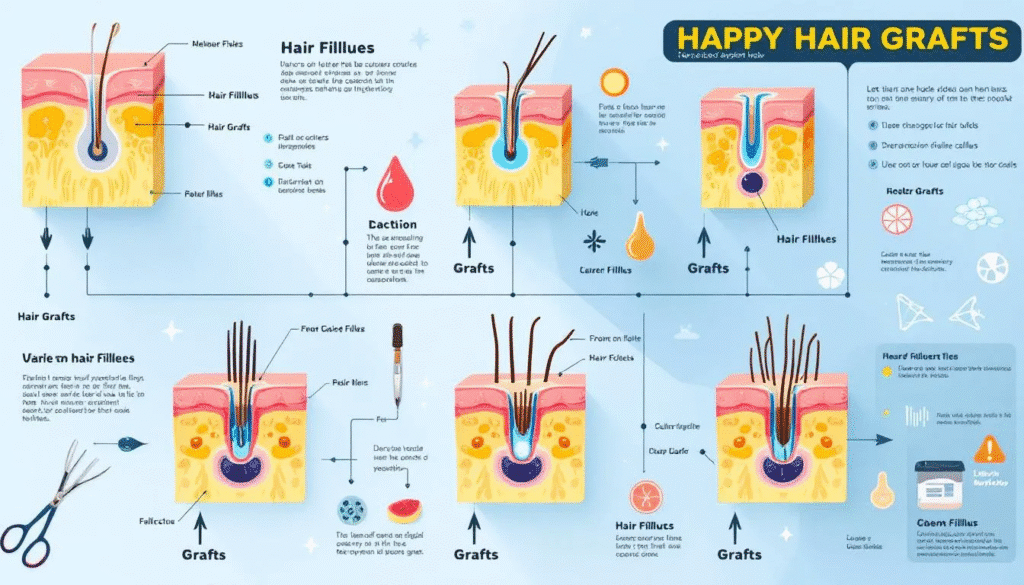
Hair grafts are the cornerstone of any successful hair transplant. Defined as small pieces of tissue containing hair follicles, these grafts are meticulously extracted from the scalp and transplanted to areas experiencing hair loss. Each graft typically houses between one to four hair follicles, making it a critical component in achieving the desired hair density and natural appearance with transplanted hair grafts. Hair grafting is essential for ensuring the best results.
The surrounding tissue of the hair follicle plays a pivotal role in providing nourishment and ensuring the survival of the graft. This skin tissue is essential for maintaining the health and viability of the hair follicles during and after the transplant procedure. On average, a successful hair transplant requires between 3000 to 4000 hair follicles, which translates to a significant number of grafts depending on the severity of hair loss.
Understanding the fundamental aspects of hair grafts sets the stage for comprehending more complex topics such as the number of hairs per graft, variations in graft types, and factors influencing graft success. By grasping these basics, one can better appreciate the meticulous planning and precision involved in hair transplantation.
How Many Hairs Does a Single Graft Contain?
A single hair graft usually comprises a cluster of hair follicles. Each graft contains:
- Anywhere from one to four hairs
- On average, around two hairs
- A range that can vary significantly, from only one hair to how many hair grafts as six hairs per graft
This variation plays a crucial role in determining the overall hair density and the natural appearance of the transplanted area.
These follicular unit grafts are the building blocks of a successful hair transplant. The number of hairs in each graft can influence the overall result, with more hairs per graft potentially leading to fewer grafts needed to achieve the desired hair density. Understanding these nuances is essential for both patients and surgeons to set realistic expectations and achieve optimal results.
Variations in Hair Grafts
Hair grafts come in various types, each serving a specific purpose in hair transplantation:
- Micro-grafts: consist of one to two hairs, ideal for creating a natural hairline.
- Mini-grafts: contain approximately two to four hairs, providing more coverage while maintaining a natural look.
- Round punch grafts: generally include around 10-15 hairs.
- Multi-hair grafts: can have up to six hairs per graft, including individual hair grafts.
Choosing the right type of hair graft is key to achieving the most natural-looking results. Single-hair grafts are often used for hairline replacement, while multi-hair grafts are more suitable for covering larger areas of hair loss. The choice of graft type is a critical decision that can significantly impact the overall appearance and success of the hair transplant.
Factors Influencing Hair Count in Grafts
Several factors can influence the number of hairs contained within a single graft. Genetics and the health of the donor area are critical determinants of the yield of hair grafts. A healthier scalp allows for a greater number of grafts to be harvested with reduced risk of scarring, which is essential for a successful hair transplant.
Hair texture also plays a significant role. Straight hair may need more grafts to achieve the same coverage as curly or wavy hair, which naturally offers more volume and density. Additionally, the overall health of the hair follicles is crucial for the effectiveness and success rate of the grafts, ensuring better hair growth and longevity post-transplant.
Average Number of Hair Grafts Needed for Transplants
The number of hair grafts needed for a successful transplant varies significantly based on the extent of hair loss and the desired hair density. For full coverage, patients typically require between 4000 and 6000 grafts, although some cases may demand up to 7000 grafts. Although this number can be daunting, it is necessary for a natural and full appearance.
Factors influencing the number of grafts required include the patient’s Norwood stage and the specific areas of hair loss. For instance, patients with a higher classification on the Norwood Scale often require more grafts due to more advanced hair loss. Understanding these factors helps in planning the transplant procedure and setting realistic expectations for the outcome.
Mild Hair Loss
For patients experiencing mild hair loss, the typical graft count required ranges from 2000 to 3000 grafts. This raises the question of how many grafts are needed to effectively address early-stage hair loss, providing a significant improvement in hair density and appearance, along with considerations for hair graft calculation.
In cases of minimal hair loss, the number of grafts required can be as low as 600, making it a less invasive option for those in the early stages of hair thinning. By addressing hair loss early, patients can achieve satisfactory results with fewer grafts, reducing the overall complexity and cost of the procedure.
Moderate Hair Loss
Patients with moderate hair loss often require around 2000 grafts to achieve effective coverage and restore a natural appearance. This level of hair loss involves noticeable thinning, which prompts the need for a more comprehensive evaluation and a well-planned transplant procedure.
Achieving a satisfactory density is crucial for patients with moderate hair loss, as it ensures that the transplanted hair blends seamlessly with the existing hair, providing a natural and aesthetically pleasing result to achieve natural looking results.
Severe Hair Loss
Severe hair loss poses significant challenges for hair restoration, often necessitating more than 5000 grafts for adequate coverage. This extensive treatment is essential for achieving the desired hair density and a natural appearance, which can be more challenging in cases of hair loss severity and advanced hair loss.
The increased graft count for severe hair loss is necessary to ensure that the entire balding area is covered effectively, as too many grafts can lead to complications. This approach helps in achieving a uniform and natural look, despite the significant challenges posed by extensive hair loss, and may require many grafts or more hair grafts to achieve optimal results.
The Importance of Healthy Hair Grafts
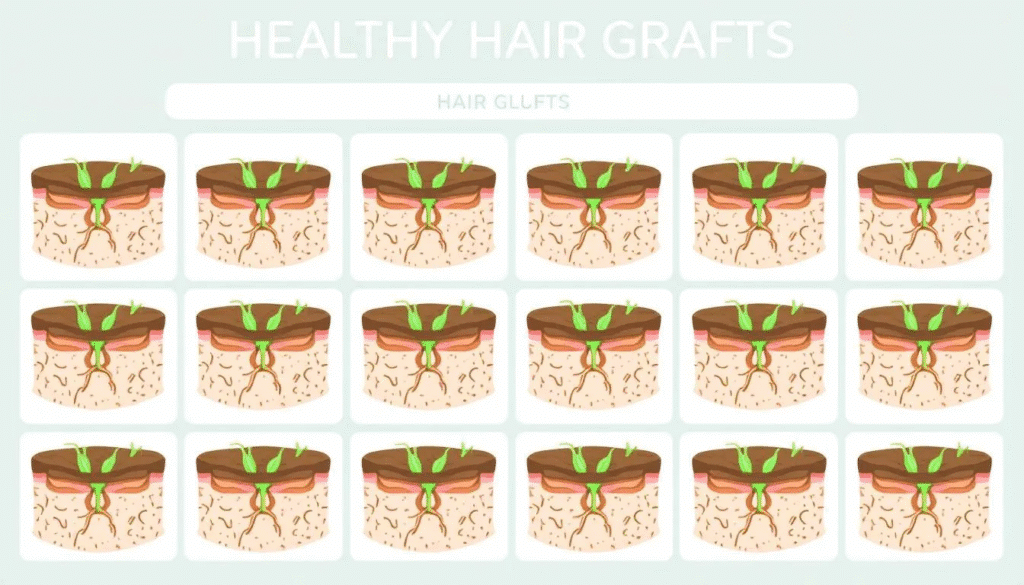
Healthy hair grafts are fundamental to the success of any hair transplant. They ensure better growth and longevity, which are critical for achieving long-term results. Grafts contain the necessary hair follicles for successful hair restoration, making their health and viability crucial.
Proper handling and preservation of transplanted grafts during the transplant procedure are vital for maintaining their graft survival rate and ensuring that grafts survive. Surgeons evaluate the health and density of the donor area to ensure that the grafts are in optimal condition, contributing to the overall success of the transplant.
Hair Characteristics and Their Impact on Graft Success
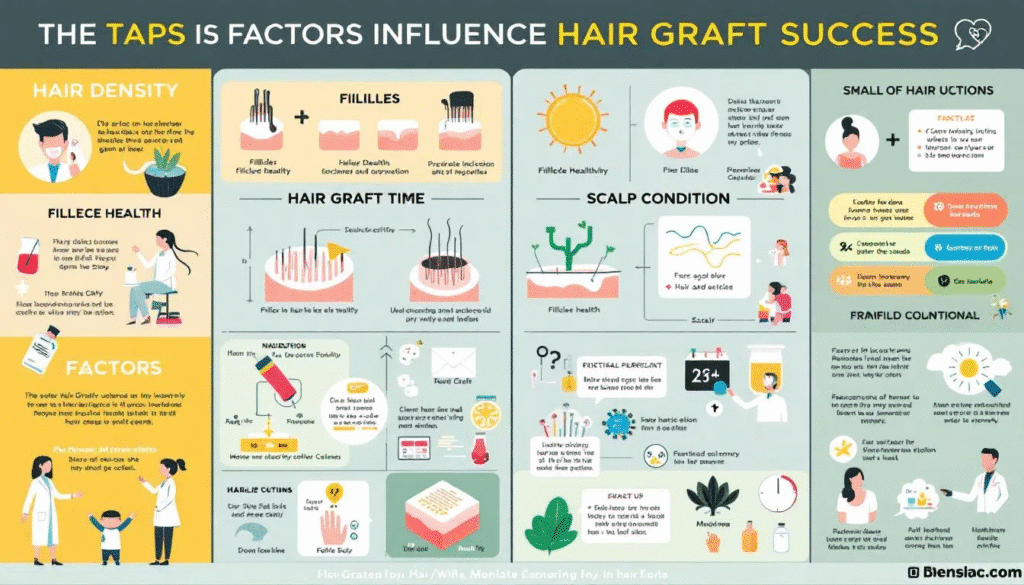
The thickness, color, and curliness of the patient’s hair are pivotal in determining the success of hair grafts. Thicker hair strands often require fewer grafts to achieve a fuller appearance, while curly hair can provide more volume and coverage with fewer grafts.
Hair color also affects how natural a transplant looks. For example, red hair, despite having fewer strands, is thicker and offers decent coverage without needing a high number of grafts. Similarly, black hair provides strong contrast with the scalp, leading to excellent coverage with fewer grafts.
These nuances underscore the importance of considering individual hair characteristics when planning a successful hair transplant.
Advanced Hair Transplant Techniques
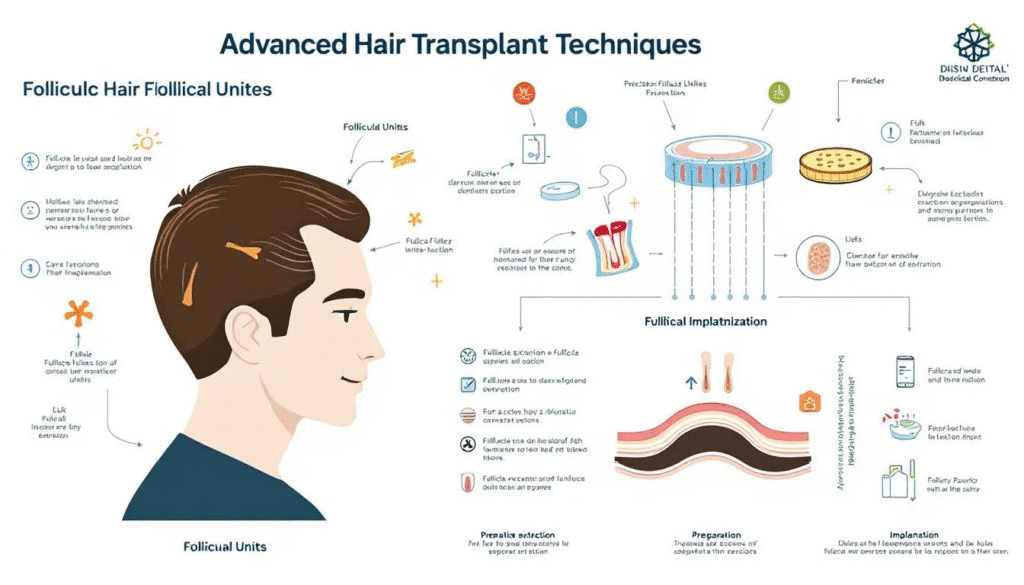
Advanced hair transplant techniques like NeoGraft and FUE hair transplant have revolutionized hair restoration with cutting edge technology. NeoGraft uses a suction method to extract hair follicles, minimizing damage compared to traditional techniques, and leading to quicker recovery times for patients.
These techniques are associated with fewer complications and improved survival rates of transplanted hair follicles due to reduced trauma during extraction. Combined with post-operative care, these advanced methods ensure the best possible outcomes, making them a preferred choice for many patients.
Case Studies: Before and After Results
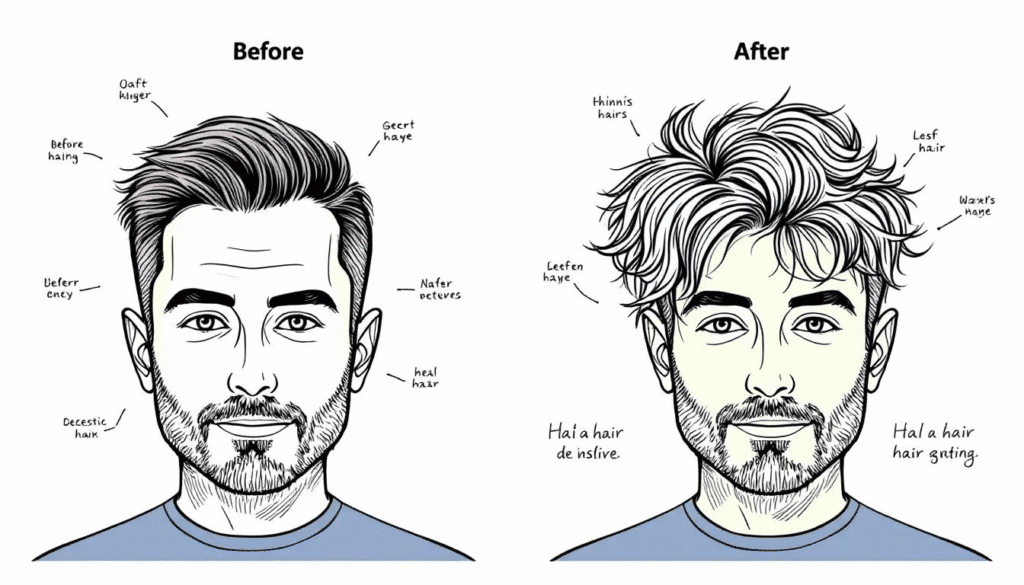
The transformative power of hair transplants is best illustrated through before-and-after photos. Most hair transplants for patients with moderate to severe balding in the crown area and other bald areas often require around 1877 grafts to achieve their desired results.
These transformations not only restore hair but significantly boost the patient’s confidence, showcasing the dramatic potential of successful hair transplantation and hair restoration surgery.
Choosing the Right Hair Transplant Clinic
Selecting the right hair transplant clinic is vital for achieving the desired results. Important factors to consider include:
- The surgeon’s expertise, which significantly affects graft outcomes.
- Choosing a clinic that encourages thorough discussions about procedures and risks.
- Avoiding clinics that pressure you into immediate decisions about surgery, as this can indicate a lack of consideration for patient well-being.
Meeting with previous patients and reviewing high-quality before and after galleries can provide valuable insights into the clinic’s results and patient satisfaction. Ensuring that the hair transplant surgery is performed by a licensed medical professional rather than technicians is vital for the success of the hair transplant procedure at hair transplant clinics, especially when considering the expertise of hair transplant surgeons and hair transplant procedures.
Summary
Hair transplants offer a promising solution for individuals struggling with hair loss. Understanding the intricacies of hair grafts, from their composition and variations to the factors influencing their success, is crucial for achieving optimal results. By choosing the right clinic and advanced techniques, patients can restore not just their hair but their confidence and self-esteem. Embrace the journey of hair restoration with informed decisions and realistic expectations, and look forward to a future with renewed confidence.
Frequently Asked Questions
How many hair grafts are typically needed for a full head transplant?
For a full head transplant, patients typically require between 4,000 and 6,000 hair grafts, with some cases necessitating up to 7,000 grafts.
What factors influence the number of hairs in a single graft?
The number of hairs in a single graft is influenced by genetics, the health of the donor area, and hair texture. A healthier scalp contributes to increased graft viability while minimizing scarring risk.
What are the different types of hair grafts used in transplants?
The different types of hair grafts used in transplants include micro-grafts, mini-grafts, round punch grafts, and multi-hair grafts, with each type designed to achieve specific aesthetic goals for a natural appearance.
How important is the health of hair grafts in a transplant?
The health of hair grafts is essential for a successful transplant, as it significantly impacts growth and longevity. Ensuring the viability of both the grafts and surrounding tissue is vital for optimal results.
How do advanced techniques like NeoGraft and FUE improve transplant outcomes?
Advanced techniques like NeoGraft and FUE enhance transplant outcomes by reducing damage during follicle extraction, resulting in quicker recovery and higher survival rates of the transplanted hair follicles. Consequently, these methods are increasingly favored for their effectiveness.

